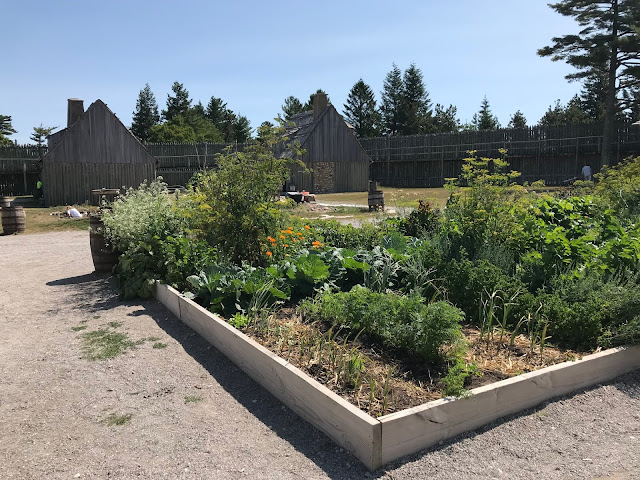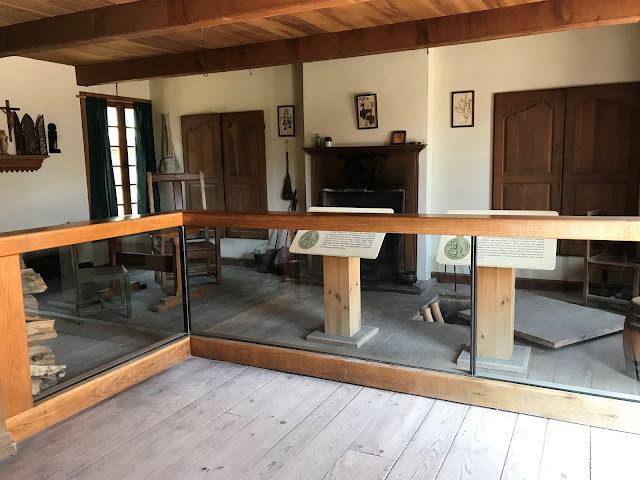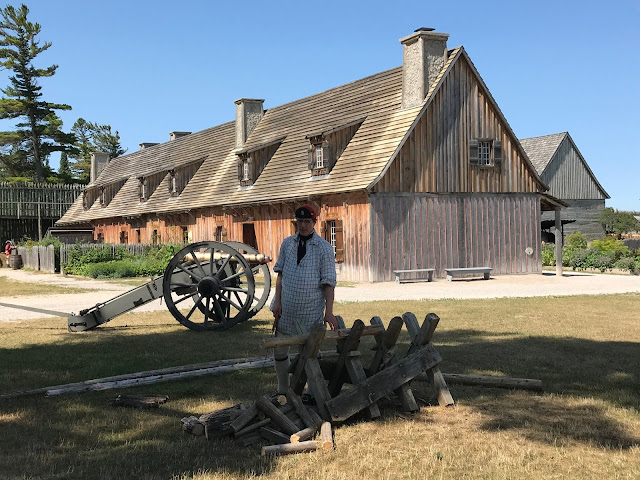Each Memorial Day weekend since 1963 - the 200th anniversary of an Indian attack at the fort, the residents of Mackinaw City reenact the history of the 18th century of British, French and Native American community. The attack was called the Massacre at Michilimackinac. The fort today, depicts how life was like during the 1700s from cannon and musket firings, hearth cooking, men sawing, soldiers, etc. and all people employed wear period costumes making the event come even more true to life.
I walked into the fort from the back side (left side of the map below, #22).
 |
| Web Photo |
 |
| This was my first look at the fort. |
So, let's do some sightseeing of Colonial Fort Michilimackinac. The first build I came to was the South-Southwest Rowhouse where the France at Mackinac exhibit, Hearthside Museum Store and Restrooms are located.
Then, came the Southwest Rowhouse where the Soldier's Home and the Merchant's House is located. Here's a found a girl sewing in period costume.
 |
| Each soldier had to make his own bread as this man is demonstrating. |
 |
| Bread then was cooked in the outdoor kiln. |
Followed by the Priest's House and Blacksmith Shop.
 |
| This is the Priest's underground cellar. |
 |
| Under the cellar is an underground museum under about 1/4 of the fort! This is what was in the Priest's cellar. |
 |
| The blacksmith's shop was adjacent to the church and Priest's house. |
Next, I saw the Guardhouse with soldiers inside..
Following this, the soldiers barracks. Gardens were near nearly every home.
From here I saw the Southeast Rowhouse containing the Solomon-Levy House - a trapper, the Powder Magazine, Lt. Clowes's house.
 |
| Excavation section of the Solomon-Levy home. |
Then, over to where someone was cutting firewood.
And, then the commanding officer's home of Lt. Col. Arent de Peyster and wife, Rebecca Blair de Peyster with a cool holographic in the house.
From here, I was close to the beach exit, but looked at the beautiful gardens, King Storehouse and Water Gate.As I exited to walk along the beach back to the visitor center, just outside the Water Gate tower is the Voyageur landing area and a Native American Indian Encampment.
This was a wonderful experience and it was a great glimpse into the life of early 18th century. I especially found it interesting with my French-Canadian genealogy. I'm so glad I went and they also offer continuous ongoing cultural events - musket demonstrations, cards and dice in the trader's house, bread making, artillery demonstrations, infantry exercises, 18th century clothing, garden tours, fur trading, etc. If you decide to go, plan on spending at least 2 hours here...possibly more. I got to the State Park at 10:30 a.m. and had to be back to Tee Pee Campground by 2:30 p.m. so Scott and I could get going to Pictured Rocks National Lakeshore for our early evening tour tonight...



















































































No comments:
Post a Comment